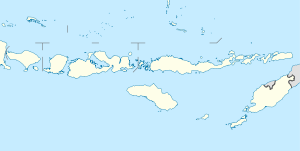North Biboki
| Kecamatan Biboki Utara North Biboki District
|
|
|---|---|
 |
|
| Basic data | |
| Country | Indonesia |
| province | East Nusa Tenggara |
| Administrative district | North Central Timor |
| Seat | Boronubes |
| surface | 138.7 km² |
| Residents | 11,176 (2017) |
| density | 81 inhabitants per km² |
| ISO 3166-2 | ID-NT |
Coordinates: 9 ° 17 ′ S , 124 ° 50 ′ E
Northern Biboki ( Indonesian Biboki Utara ) is an Indonesian district ( Kecamatan ) in the west of the island of Timor .
geography
| "Village" (Desa / Kelurahan) | Administrative headquarters | surface | Residents | Population density |
|---|---|---|---|---|
| Sapaen | Sapaen | 6.30 km² | 817 | 130 |
| Taunbaen | Oenali | 11.20 km² | 813 | 73 |
| Tualene | Inggureo | 18.00 km² | 1,882 | 105 |
| Biloe | Neofana | 16.50 km² | 1,398 | 85 |
| Hauteas | Lurasik | 6.40 km² | 1,164 | 182 |
| Boronubes | Aibano oan | 18.00 km² | 1,793 | 64 |
| Lokomea | Brseon | 28.20 km² | 950 | 53 |
| East boronubes | Oeroki | 20.00 km² | 840 | 42 |
| Westhauteas | Banoko | 5.60 km² | 781 | 139 |
| East Taunbaen | Neofmuti | 8.50 km² | 738 | 87 |
Location in East Nusa Tenggara Province
|
The district is located in the northeast of the administrative district of North Central Timor (Timor Tengah Utara) in the province of East Nusa Tenggara (Nusa Tenggara Timur) . In the north of the district is Biboki Feotleu , west Südbiboki (Biboki Selatan) and southwest Biboki Tanpah . In the northeast, North Biboki borders on the administrative district of Belu with its district of West Tasifeto (Tasifeto Barat) and in the southeast of the administrative district of Malaka with its district of Rai Manuk .
North Biboki has an area of 138.70 km² and is divided into the nine Desa Tualene and Boronubaen in the south, Hauteas and Westhauteas (Hauteas Barat) in the eastern center, Lokomea and Biloe in the north and Sapaen , Taunbaen and Osttaunbaen (Taunbaen Timur) in the west . In addition there is the Kelurahan Ostboronubaen (Boronubaen Timur) in the east. The administrative headquarters are in Boronubaen. The Desas Sapaen, Taunbaen, Biloe are located at an altitude of over 700 m and the rest of the district's territory is between 500 m and 700 m . As usual in Timor, the climate is divided into a rainy and a dry season .
flora
In the district to find occurrences of Lontar palm trees , bamboo , coconut , teak , mahogany and Lamtoro.
Residents
In 2017 there were 11,176 residents in North Biboki. 5,575 were men, 5,601 women. The population density was 81 people per square kilometer. 9,852 people professed their Catholic faith, 1,306 were Protestants and 18 people were Muslim. There were seven Catholic and four Protestant churches in the district.
Economy, infrastructure and transport
Most of the district's residents make a living from agriculture. Cattle (6,794), horses (22), pigs (3,719), goats (2,398), ducks (471) and chickens (21,722) are kept as pets. Maize is grown on 996 hectares, 1,468 hectares of rice, 228 hectares of cassava, 40 hectares of sweet potatoes, 35 hectares of peanuts and 18 hectares of green beans. Other agricultural products include onions, cabbage, mustard, chilli, tomatoes, water spinach and spinach.
There are eleven elementary schools, five middle schools and one secondary school in North Biboki. A municipal health center ( Puskesmas ), two medical care centers ( Puskesmas Pembantu ) and seven midwifery centers ( Polindes ) are available for medical care .
Public transport is operated by four minibuses, 36 pick ups, twelve trucks, six buses and 95 motorcycles.
Web links
- Statistical data from North Biboki District 2018 (Indonesian).

